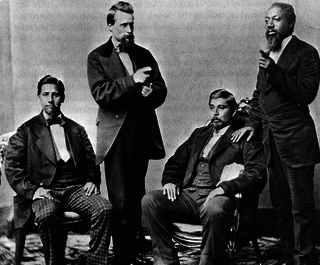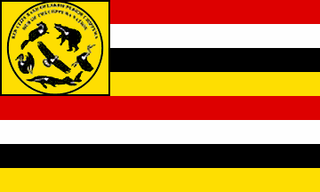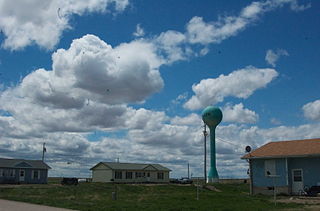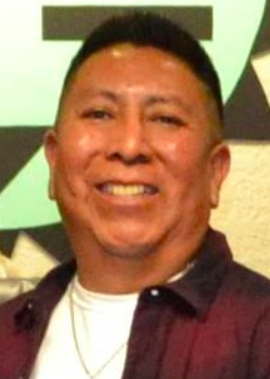
Tribal sovereignty in the United States is the concept of the inherent authority of Indigenous tribes to govern themselves within the borders of the United States.

The Red Lake Indian Reservation covers 1,260.3 sq mi in parts of nine counties in Minnesota, United States.

Saginaw Chippewa Indian Tribe of Michigan is a federally recognized band of Chippewa located in central Michigan in the United States.

An Indian reservation is an area of land held and governed by a U.S. federal government-recognized Native American tribal nation, whose government is semi-sovereign, subject to regulations passed by the United States Congress and administered by the United States Bureau of Indian Affairs, and not to the U.S. state government in which it is located. Some of the country's 574 federally recognized tribes govern more than one of the 326 Indian reservations in the United States, while some share reservations, and others have no reservation at all. Historical piecemeal land allocations under the Dawes Act facilitated sales to non–Native Americans, resulting in some reservations becoming severely fragmented, with pieces of tribal and privately held land being treated as separate enclaves. This jumble of private and public real estate creates significant administrative, political, and legal difficulties.

Blood quantum laws or Indian blood laws are laws in the United States that define Native American status by fractions of Native American ancestry. These laws were enacted by the federal government and state governments as a way to establish legally defined racial population groups. By contrast, many tribes do not include blood quantum as part of their own enrollment criteria.

The Sault Ste. Marie Tribe of Chippewa Indians, commonly shortened to Sault Tribe of Chippewa Indians or the more colloquial Soo Tribe, is a federally recognized Native American tribe in what is now known as Michigan's Upper Peninsula. The tribal headquarters is located within Sault Ste. Marie, the major city in the region, which is located on the St. Marys River.

The Leech Lake Reservation is an Indian reservation located in the north-central Minnesota counties of Cass, Itasca, Beltrami, and Hubbard. The reservation forms the land base for the federally recognized Leech Lake Band of Ojibwe, one of six bands comprising the Minnesota Chippewa Tribe, organized in 1934. The Leech Lake Reservation has the second highest population of any reservation in Minnesota with White Earth Nation being the largest Minnesota Ojibwe tribe, Leech Lake Nation has a resident population of 11,388 indicated by the 2020 census.

Red Cliff Band of Lake Superior Chippewa is a band of Ojibwe Native Americans. The Red Cliff Band is located on the Red Cliff Indian Reservation, on Lake Superior in Bayfield County, Wisconsin. Red Cliff, Wisconsin, is the administrative center. Red Cliff is notable for being the band closest to the spiritual center of the Ojibwe nation, Madeline Island. As of November 2010, there were 5,312 enrolled members, with about half living on the reservation and the rest living in the city of Bayfield or the Belanger Settlement.

The Little Traverse Bay Bands of Odawa Indians is a federally recognized Native American tribe of Odawa. A large percentage of the more than 4000 tribal members continue to reside within the tribe's traditional homelands on the northwestern shores of the state of Michigan's Lower Peninsula. The historically delineated reservation area, located at 45°21′12″N84°58′41″W, encompasses approximately 336 square miles (870 km2) of land in Charlevoix and Emmet counties. The largest communities within the reservation boundaries are Harbor Springs, where the tribal offices are located; Petoskey, where the Tribe operates the Odawa Casino Resort; and Charlevoix.

Reservations in the United States, known as Indian reservations, are sovereign Native American territories that are managed by a tribal government in cooperation with the federal Bureau of Indian Affairs, a branch of the Department of the Interior, located in Washington, DC. There are 334 reservations in the United States today. As of 2008, almost a third of Native Americans in the United States live on reservations, totaling approximately 700,000 individuals. About half of all Native Americans living on reservations are concentrated on the ten largest reservations.
The Harvard Project on American Indian Economic Development, also known as the Harvard Project, was founded in 1987 at Harvard Kennedy School at Harvard University. It administers tribal awards programs as well as provides support for students and conducting research. The Harvard Project aims to understand and foster the conditions under which sustained, self-determined social and economic development is achieved among American Indian nations through applied research and service.
The impact of Native American gaming depends on the tribe and its location. In the 1970s, various tribes took unprecedented action to initiate gaming enterprises. In this revitalization of the Native American economy, they created a series of legal struggles between the federal, state, and tribal governments. Gaming has stimulated tribal economies by providing jobs and generating revenue but has also been controversial through its threat to tribal sovereignty, disputes over the negative impact of gaming, and a loss of Native American culture. The Indian Gaming Regulatory Act was passed in 1988 to secure collaboration between the states and tribes and also for the federal government to oversee gaming operations.
Native American reservation inequality underlies a range of societal issues that affect the lives of Native American populations residing on reservations in the United States. About one third of the Native American population, about 700,000 people, lives on an Indian Reservation in the United States. Reservation poverty and other discriminatory factors have led to persisting social inequality on Native American reservations. Disparities between many aspects of life at the national level and at the reservation level, such as quality of education, quality of healthcare, substance use disorders, teenage pregnancy, violence, and suicide rates are significant in demonstrating the inequality of opportunities and situations between reservations and the rest of the country.
Marcos Antonio Moreno is an American physician, public health advocate and medical research scholar. He is of Mexican and Native American descent, and an enrolled citizen of the Pascua Yaqui Tribe from the Pascua Yaqui Reservation in southern Arizona. He is a graduate of Cornell University, where he studied Neuroscience, and American Indian Studies. He is the first person from the Pascua Yaqui Reservation to graduate from an Ivy League University, and thus far is the only Doctor of Medicine from the Yaqui's reservation community. He received his Doctor of Medicine degree from UND-School of Medicine and Health Sciences and is a resident physician at Yale University in the Department of Psychiatry.

State, territorial, tribal, and local governments responded to the COVID-19 pandemic in the United States with various declarations of emergency, closure of schools and public meeting places, lockdowns, and other restrictions intended to slow the progression of the virus.
Red Dawn Foster is an American politician serving as a member of the South Dakota Senate from the 27th district, which encompasses the Pine Ridge Reservation as well as Bennett, Haakon, Jackson, Pennington and Oglala Lakota counties. Elected in November 2018, she assumed office on January 8, 2019 and is the current incumbent.

On March 17, 2020, the COVID-19 pandemic was reported to have reached the Navajo Nation. The virus then spread rapidly through the Navajo Nation to the point that the Navajo, in 2020, had a higher per capita rate of infection than any state of the United States. The population according to the 2010 United States census was 173,667. As of September 13, 2022, the number of confirmed cases was 31,571 with 1,893 deaths.

Timothy Nuvangyaoma is a Hopi politician and firefighter. He serves as the chairperson and tribal leader of the Hopi Reservation in Arizona in the United States.













